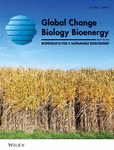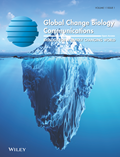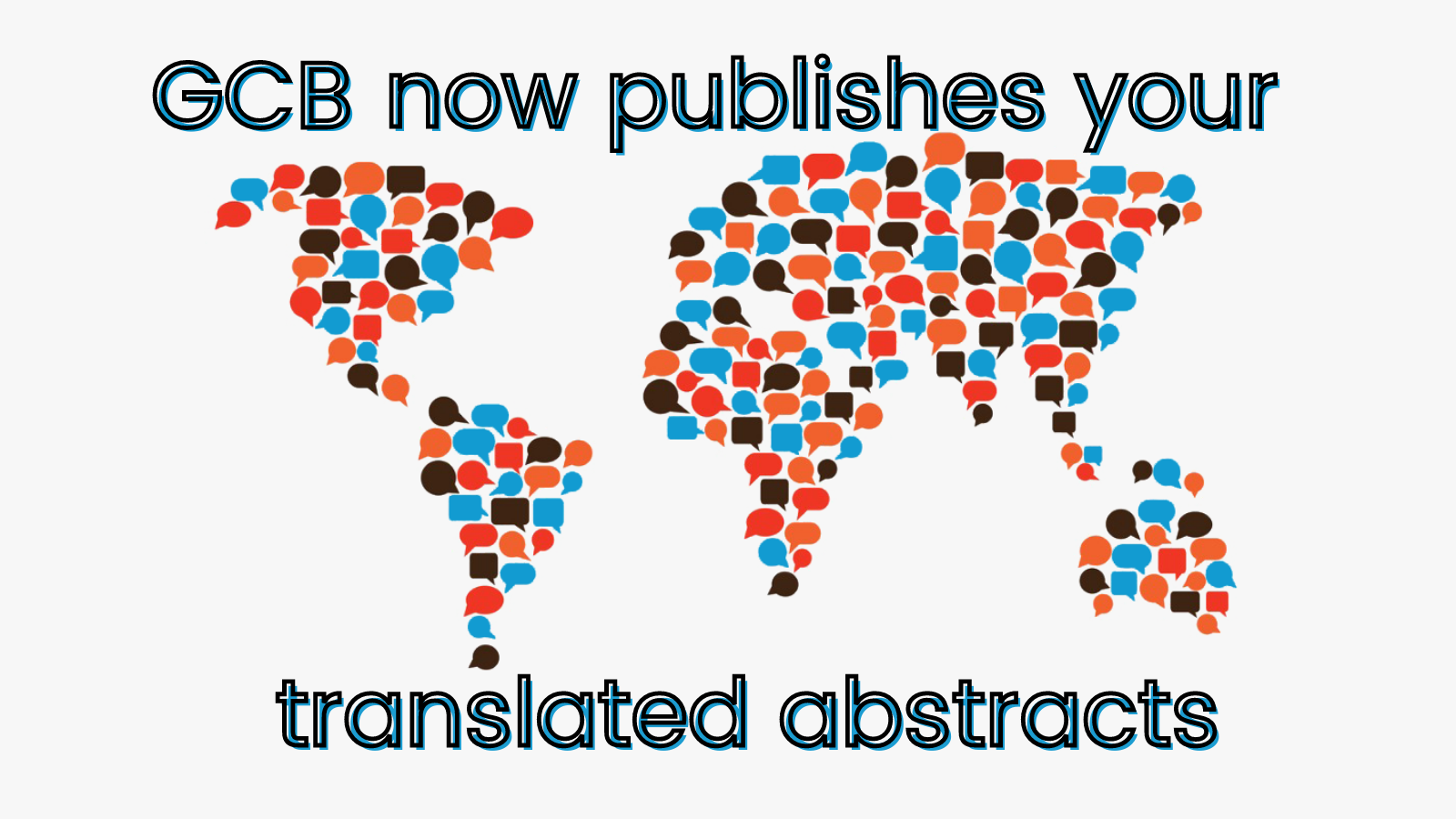Journal list menu
Export Citations
Download PDFs
Letter to the Editor
Denial of long-term issues with agriculture on tropical peatlands will have devastating consequences
- Pages: 977-982
- First Published: 27 September 2016
Editorial Commentary
Agricultural intensification and drought frequency increases may have landscape-level consequences for ephemeral ecosystems
- Pages: 983-985
- First Published: 21 November 2016
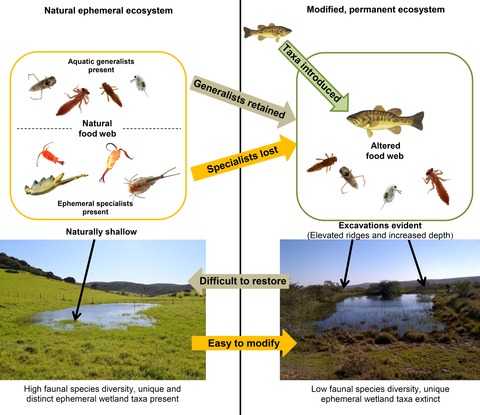
Ephemeral wetlands in arid regions are often degraded or destroyed through poor land-use practice long before they are ever studied or prioritized for conservation. Climate change will likely also have implications for these ecosystems given forecast changes in rainfall patterns in many arid environments. Here, we present a conceptual diagram showing typical and modified ephemeral wetlands in agricultural landscapes and how modification impacts on species diversity and composition.
Primary Research Articles
Urban ponds as an aquatic biodiversity resource in modified landscapes
- Pages: 986-999
- First Published: 01 August 2016
Climate change is projected to reduce carrying capacity and redistribute species richness in North Pacific pelagic marine ecosystems
- Pages: 1000-1008
- First Published: 22 August 2016
Fishing degrades size structure of coral reef fish communities
- Pages: 1009-1022
- First Published: 26 August 2016
Species-specific responses to climate change and community composition determine future calcification rates of Florida Keys reefs
- Pages: 1023-1035
- First Published: 26 August 2016
Barren-ground caribou (Rangifer tarandus groenlandicus) behaviour after recent fire events; integrating caribou telemetry data with Landsat fire detection techniques
- Pages: 1036-1047
- First Published: 10 August 2016
Mechanistic variables can enhance predictive models of endotherm distributions: the American pika under current, past, and future climates
- Pages: 1048-1064
- First Published: 08 August 2016
The unseen invaders: introduced earthworms as drivers of change in plant communities in North American forests (a meta-analysis)
- Pages: 1065-1074
- First Published: 03 September 2016
Lizards fail to plastically adjust nesting behavior or thermal tolerance as needed to buffer populations from climate warming
- Pages: 1075-1084
- First Published: 25 August 2016
Rapid climate-driven loss of breeding habitat for Arctic migratory birds
- Pages: 1085-1094
- First Published: 30 June 2016
Press–pulse interactions: effects of warming, N deposition, altered winter precipitation, and fire on desert grassland community structure and dynamics
- Pages: 1095-1108
- First Published: 09 September 2016
Rapid carbon loss and slow recovery following permafrost thaw in boreal peatlands
- Pages: 1109-1127
- First Published: 30 June 2016
Rising plant-mediated methane emissions from arctic wetlands
- Pages: 1128-1139
- First Published: 19 August 2016
Stomatal response to humidity and CO2 implicated in recent decline in US evaporation
- Pages: 1140-1151
- First Published: 20 July 2016
Spatial and temporal dimensions of fire activity in the fire-prone eastern Canadian taiga
- Pages: 1152-1166
- First Published: 11 August 2016
Grazing intensity significantly affects belowground carbon and nitrogen cycling in grassland ecosystems: a meta-analysis
- Pages: 1167-1179
- First Published: 14 July 2016
Contrasting ecosystem CO2 fluxes of inland and coastal wetlands: a meta-analysis of eddy covariance data
- Pages: 1180-1198
- First Published: 11 July 2016
Landscape dynamics in Mediterranean oak forests under global change: understanding the role of anthropogenic and environmental drivers across forest types
- Pages: 1199-1217
- First Published: 02 September 2016
Patterns of structural and defense investments in fine roots of Scots pine (Pinus sylvestris L.) across a strong temperature and latitudinal gradient in Europe
- Pages: 1218-1231
- First Published: 27 September 2016
Stability in a changing world – palm community dynamics in the hyperdiverse western Amazon over 17 years
- Pages: 1232-1239
- First Published: 10 September 2016
Partitioning controls on Amazon forest photosynthesis between environmental and biotic factors at hourly to interannual timescales
- Pages: 1240-1257
- First Published: 19 September 2016
A potato model intercomparison across varying climates and productivity levels
- Pages: 1258-1281
- First Published: 07 July 2016
Plant invasion is associated with higher plant–soil nutrient concentrations in nutrient-poor environments
- Pages: 1282-1291
- First Published: 07 June 2016
Atmospheric CO2 enrichment and drought stress modify root exudation of barley
- Pages: 1292-1304
- First Published: 16 September 2016
Tracking lags in historical plant species’ shifts in relation to regional climate change
- Pages: 1305-1315
- First Published: 14 July 2016
Sensitivity of soil carbon fractions and their specific stabilization mechanisms to extreme soil warming in a subarctic grassland
- Pages: 1316-1327
- First Published: 03 September 2016
Costimulation of soil glycosidase activity and soil respiration by nitrogen addition
- Pages: 1328-1337
- First Published: 30 June 2016
A meta-analysis of soil salinization effects on nitrogen pools, cycles and fluxes in coastal ecosystems
- Pages: 1338-1352
- First Published: 14 July 2016
Technical Advance
Integrated population modeling reveals the impact of climate on the survival of juvenile emperor penguins
- Pages: 1353-1359
- First Published: 22 October 2016
Corrigendum
Modelling marine community responses to climate-driven species redistribution to guide monitoring and adaptive ecosystem-based management
- Page: 1360
- First Published: 17 February 2017
Response to Editor
A response to ‘Trends in tropical tree growth: reanalysis confirms earlier findings’
- Pages: e5-e6
- First Published: 20 December 2016
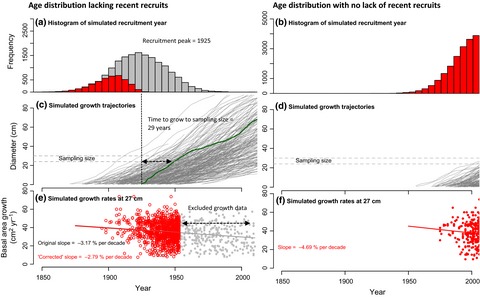
We recently demonstrated that growth trends from tree rings from Van Der Sleen et al. (Nature Geoscience, 8, 2015, 24) and Groenendijk et al. (Global Change Biology, 21, 2015, 3762) are affected by demographic biases. In particular, clustered age distributions led to a negative bias in their growth trends. In a response, they challenge our analysis and present an alternative correction approach. We here show that their arguments are incorrect and based on misunderstanding of our analysis and that their alternative approach does not work.





